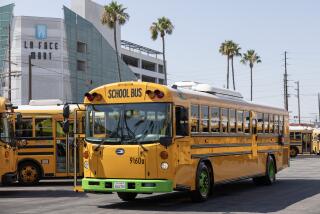Schools Must Have a Public
- Share via
Americans fashioned a system for governing the country that left individuals free to do whatever they thought best. Yet we knew from the very beginning that unbridled individualism would do us in if we didn’t have something to bind us together. So we agreed on a Constitution with a common set of laws. We raised barns together and told stories about the past in order to impress upon the next generation the importance of mutual aid. We created symbols to evoke a shared sense of allegiance. And we built public schools, schools free to all and common to almost all. In Los Angeles, the first of these schools appeared on the corner of Second and Spring streets in 1855.
Of course, schools were expected to educate individual children, but in doing that they served a larger purpose. Educating children was to “complete the great work of the Revolution,” to create a nation where freedom was joined by justice, civic virtue and social responsibility. Public schools were to give us order without the coercion of an all-powerful government. Common schools were to make real communities out of frontier settlements. As one historian characterized our history, we chose individual freedom that bordered on anarchy--but with a schoolmaster on hand to shape our character so that freedom would not become irresponsible license.
Public schools were not public just because they were paid for by tax revenues and controlled by boards of citizens. They were the public’s schools, chartered to serve public purposes.
That’s what I grew up believing, in a family of schoolteachers; it’s what I believed as a professor of American history, and it’s what I believed as secretary of health, education and welfare on the bicentennial of our independence.
Is America still committed to its public schools? If you ask citizens if they support these schools, they usually say “yes.” According to a poll conducted by the California Public Education Partnership and reported in The Times on May 23, eight out of 10 respondents agreed that California has a duty to provide a good education for all children.
Public schools educate most of America’s young people, about 40 million of them. Research at the Kettering Foundation suggests, however, that this commitment may not be as unequivocal as it first appears. Many Americans no longer believe that the public schools are their schools.
You would think that such a major shift in attitudes and allegiances would be a big issue, particularly given the implications for a democracy struggling with order, coherence and virtue. It isn’t, except for some recent stories in publications directed primarily at educators. But just think about the consequences of the collapse of our commitment to public schooling as we have known it.
Concerned about these consequences, Kettering is releasing the results of years of study on the deteriorating relationship between the public and the schools. We also have some thoughts about how to recharter public schools, but we aren’t talking about campaigns to generate financial support or “involve the public.” We have been studying the problems behind the problems, behind the symptoms of failed tax levies and increased criticism of curriculum.
Our conclusion is obvious: We can’t have public schools without a public. The logic of that deduction isn’t lost on Los Angeles, because civic leaders have already used The Times commentary section to make the case that only public involvement can get the city back to the original intent for the schools. Unfortunately, in many cities, public life (the life built around the things we have in common) isn’t strong enough to do what has to be done. In a report widely circulated in California, the Committee on Economic Development came to the same conclusion, reporting that “without social capital to sustain problem-solving within distressed communities and to link community residents to the broader society, efforts to address specific problems of individuals, families and neighborhoods will make little progress.”
Recall how we chartered public schools in the first place. We didn’t start by creating missions for schools, we started by deciding the purposes of our communities, the imperatives for our country. Schools can’t solve all of our social and economic problems; their primary function is to educate their students. Yet we have found the overarching rationale for public schools is in completing the “great work of the Revolution.” Today, we may have to retrace our steps, not to the original Revolution, but to the imperatives of America in 1996.
More to Read
Sign up for Essential California
The most important California stories and recommendations in your inbox every morning.
You may occasionally receive promotional content from the Los Angeles Times.













